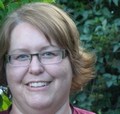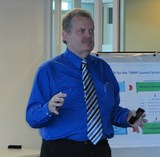Designing for Tomorrow 2014: Alberta partnership presents "14th Annual Stormwater Management Courses"
Note to Reader:
To download a copy of the brochure that provides complete program details, click on Designing for Tomorrow 2014.
Alberta Low Impact Development Partnership features modelling course taught by Dr. Charles Rowney
Formed in 2004, the Alberta Low Impact Development Partnership (ALIDP) offers training, expertise & networking to professionals seeking to implement sustainable urban rainwater/stormwater management solutions suitable for the Northern Prairies. Each year, ALIDP presents a suite of courses encompassing training, certification and policy development.
 The 2014 program features a one-day course taught by Dr. A. Charles Rowney and titled Modelling with QUALHYMO. A recognized global authority in his fields of expertise, he brings a wealth of North American and international experience. He is the Scientific Authority for the Water Balance Model for British Columbia. QUALYMO is the calculation engine for this web-based scenario comparison and decision support tool.
The 2014 program features a one-day course taught by Dr. A. Charles Rowney and titled Modelling with QUALHYMO. A recognized global authority in his fields of expertise, he brings a wealth of North American and international experience. He is the Scientific Authority for the Water Balance Model for British Columbia. QUALYMO is the calculation engine for this web-based scenario comparison and decision support tool.
About Dr. Charles Rowney
Dr. Rowney has over 30 years of experience in water resources science and engineering. He has been active both as an academic and in private industry, and for the last decade he has practiced independently. Project and research experience has spanned Canada and extended across North America and Europe.
He has a strong background in water resources planning, analysis, management and operation, including extensive Best Management Practices (BMP) and LID experience.
He is a current and accomplished water resources modeller, who routinely combines water resources knowledge and computing skills in environmental projects encompassing surface, subsurface, quality/quantity control and receiving water systems across the range of North American climate conditions and project requirements.
As well as being an accomplished model user and implementer, Dr. Rowney is a model developer who has many computer model development projects to his credit.
Modelling with QUALHYMO
“QUALHYMO has been used for over two decades as one of the prime tools for sizing of stormwater management ponds and demonstrating the sediment removal by these facilities,” reports Leta van Duin, ALIDP Executive Director.

“Dr. Rowney, who was one of the two authors of this tool, has completely overhauled and updated the computational procedures in QUALHYMO, adding extensive procedures for the modelling of Source Control Practices, thus allowing for the full representation of LID within overall stormwater management.”
“In addition, the model now has a visual interface and graphics capabilities which will be a relief to everyone who has had to struggle with the text files of previous versions! The course will discuss the changes made and new features added, and will demonstrate how the performance of LID can be modelled with a high degree of certainty.”
“QUALYHYMO is an approved rainfall-runoff model for The City of Calgary. This is a vastly improved version of QUALHYMO/QHM that is still often being used for the design of storm ponds in Calgary. As an alternative to the sledgehammer of SWMM, this new QUALHYMO is of specific interest for a holistic water quantity + quality evaluation of LID features on private sites. We are privileged to have Dr. Charles Rowney, the author of this model, presenting this course in person.”
Quotable Quotes
“Watershed and drainage models are not a ‘one size fits all’ item. These tools each have pluses and minuses, and tend to reflect the regulatory and physical context for which they were first developed,” states Charles Rowney.
“Even the modellers who use them very effectively can have unconscious biases which reflect from the places they practice and the tools they use. This is probably a great place to remember the old saying, that ‘if you have a hammer the whole world looks like a nail’. So the challenge we face is to find modeling technologies that are right for our needs, the solutions we prefer, and the processes we have developed.”
To Learn More:
To download a copy of the brochure that provides complete details of the 14th Annual Stormwater Management Courses, click on Designing for Tomorrow 2014.
To access the first story in a 2-part series featuring Dr. Charles Rowney, click on Drainage Modelling in the 21st Century: What are the impediments to success?
To access the second story in the 2-part series,, click on Drainage Modelling in the 21st Century: The Uncertainty Cascade.

April 2011 – Charles Rowney explains modelling fundamentals at a Water Balance Model Partners Forum hosted by Metro Vancouver


